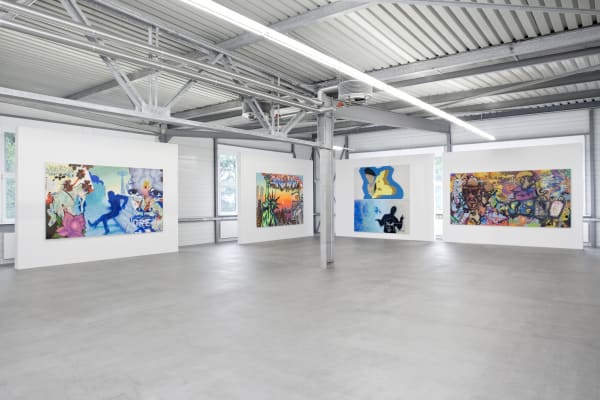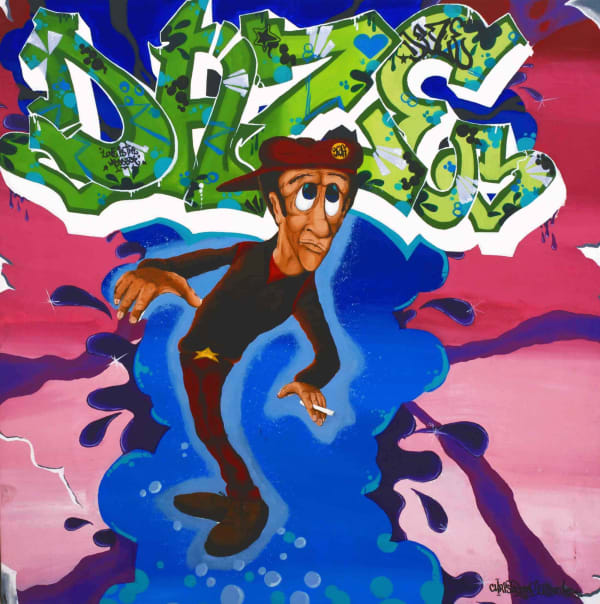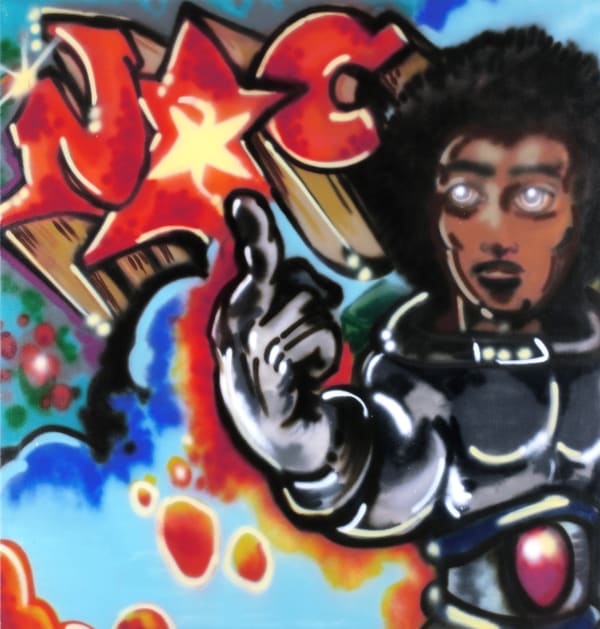The Speerstra Collection brings together emblematic works from the New York post-graffiti movement of the 80's. This mayor ensemble features works by such key, innovative members as Crash, Daze, JonOne, Dondi White, Futura 2000, Rammellzee and Lady Pink. The collection shows us how the original practice of lettering developed and moved gradually towards figuration or abstraction. We witness two successive generations, in the 70's and 80's, a period that saw an increasing crossover of styles, genres and influences between graffiti and the codes of contemporary art.
In the late 70's, the city of New York was undergoing a financial crisis. A number of neighbourhoods were in decline, people were moving out. Here was an ideal terrain for the graffiti artists to develop their creativity. A variety of styles emerged in these works that sprang up on the concrete walls and vied with each other for size. Brightly coloured signatures spread over buildings and tunnels. In a kind of overkill, a sometimes caricature vision of fame, the artists spread their names and nicknames over whole subway trains. New York was the territory and hotbed of young talents thirsty for recognition. They appropriated the city and created a new poetics of urban space and life. New York graffiti emerged at the heart of the mixed hip-hop culture. It was characterised by codified forms and implies adhesion to a shared vocabulary and set of tastes. It was also a way of communicating, of leaving a trace of presence, a testament. In the 70's, Henry Chalfant and Martha Cooper began photographing and archiving paintings in the subway and went to meet the young artists. In 1984 they popularised the graffiti phenomenon by co-publishing "Subway Art", a book that played an important role in disseminating this writing art beyond the city of New York itself. Chalfant's photos are an essential part of the Speerstra Collection and record the first works of Futura 2000, Dondi White, Seen and many others.
While at the end of the 70's, the municipality and New York subway company began trying to eradicate graffiti, art dealers were becoming increasingly interested in the practice and trying to exhibit it. The artists Lee Quinones, Seen and Futura 2000 started painting on canvas. It was soon possible to see their works at Patti Astor's Fun Gallery, at Tony Shafrazi's Fashion Moda and at the Sydney Janis Gallery. These commercial outings brought the first rifts within the movement. The ephemeral urban practice of the early days was being redefined. But not everyone objected to the new art-world legitimacy. The artists could now devote themselves to their work and experiment with new techniques. By transferring to canvas, urban graffiti became post-graffiti. In addition to spray paint, the artists in the Speerstra Collection were quick to try out other techniques and media, such as stencils, painted posters, stickers, collage and silkscreening. By way of an example, polyptych by Crash titled Iron Horse comprises sheets of metal, stretches and collage. It was an effervescent period, and collaborations between graffiti and mainstream contemporary artists multiplied. In 1983, for example, Lady Pink, the first woman to do graffiti, began a dialogue with Jenny Holzer, an artist known for the feminist engagement in her work. Similarly, a large-format canvas painted by Crash, Daze (who had shared a studio from the outset) and A One (1984) combines their very different styles while illustrating real mutual respect. Common practices were conceived as playful springboards to creative encounters. These collaborative works recaptured the freshness of urban practices, which often work by an accumulation of successive interventions.
Little by little, graffiti won recognition from both institutions and the market. The Speerstra Collection reflects this emergence, while inviting viewers to revive memories of a particular period through its explicit references to New York. The lettering of Blade, Seen, Crash and Zephyr directly evokes the transferral from urban space to canvas by reprising the horizontal form of the subway wagon. In a youthful work by Sharp (Sharp, 1984) we can observe the young graffiti artist's hesitancy about freezing his signature as he tries to imitate his peers. What we detect behind the graffitist's traditional signature, or blaze, is a need to assert an identity. In her canvases, Lady Pink affirms her idea of femininity, managing in the process to establish her position in a world strongly marked by an image of virility. Although taken out of their original urban context, her works are a medium of contestation. In the canvas titled Exile Daze presents himself and his doubts in relation to the art world. Explicit autobiographical elements present the artist's scepticism with regard to what he sees of the European geopolitical situation.
Graffiti was also inspired by comics and poster art, with a perceptible influence from American Pop Art. In addition to the world of music, the development of comics and cartoons in America built up a reservoir of images that graffiti writers revisited and put to work. Some, like Crash and Daze, used their codes. Others made their presence felt through several different kinds of practice. The legendary experimental musician Rammellzee, for example, frantically mashed up several different activities and invented the notion of gothic futurism, defining urban space as both mystical and distressing, a field for the clash between letters of the alphabet. As for Futura 2000, he has integrated into his visual vocabulary both elements of lettering and references to abstract painting, while JonOne, an artist from the second generation in New York, amalgamates several media, resulting in canvases that give an impression of profusion, with a patchwork of colours inspired by his Dominican origins.
The works in the Speerstra Collection transcribe the memory of New York in the 80's. Post-graffiti art comes across as the mirror of a period and a society, a laboratory of influences at the intersection of several different disciplines and cultures. It constitutes a rare source which offers keys to the understanding of contemporary graffiti.
© Speerstra Collection
-
-

DAZE / Electric Boogie
1982
acrylique sur toile - acrylic on canvas
140 x 140 cm
-

BLADE / Hapiness Is
1984
spray sur toile - spray paint on canvas
185 x 215 cm
-

RAMMELLZEE / Wild Style Letter B
1990
technique mixte sur toile - mixed media on canvas
195 x 175 cm
-

JonOne / Poetry of Colors
1992
acrylique sur toile - acrylic on canvas
130 x 112 cm
-

CRASH / Smoking
1981
spray sur toile - spray paint on canvas
130 x 245 cm
-

DONDI WHITE / 1100 Francks
1982
spray sur toile - spray paint on canvas
130 x 240 cm
-

FUTURA 2000 / Eliminator
1984
spray sur toile - spray paint on canvas
133 x 189 cm
-

SHARP / Untitled
1984
spray sur toile - spray paint on canvas
186 x 395 cm
-

QUIK / Graffiti
1984
spray sur toile - spray paint on canvas
205 x 205 cm
-

LADY PINK / Dolly
1985
spray sur toile - spray paint on canvas
162 x 137 cm
-

A ONE / Soul on Ice
1992
spray sur toile - spray paint on canvas
203 x 203 cm
-

NOC 167 / Outer of space being
1984
spray sur toile - spray paint on canvas
175 x 180 cm
-
-
 A ONE, CRASH & DAZE - 1984 - 800 x 200 cm - spray sur toile - spray paint on canvas
A ONE, CRASH & DAZE - 1984 - 800 x 200 cm - spray sur toile - spray paint on canvas -




























